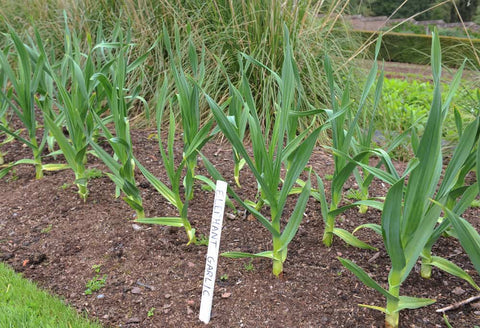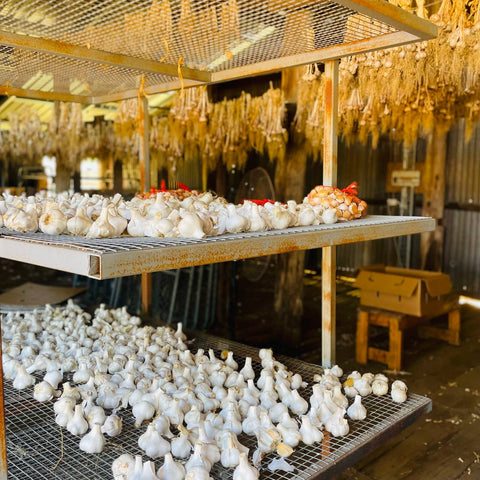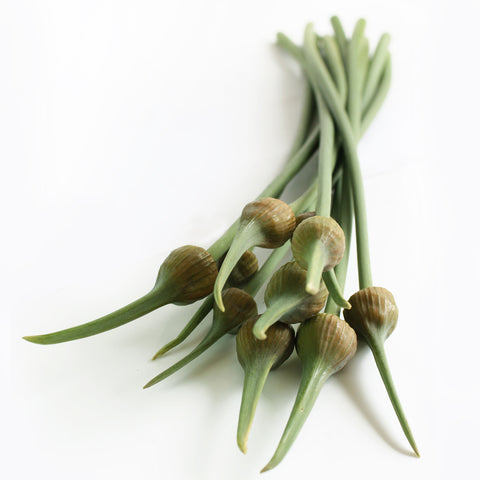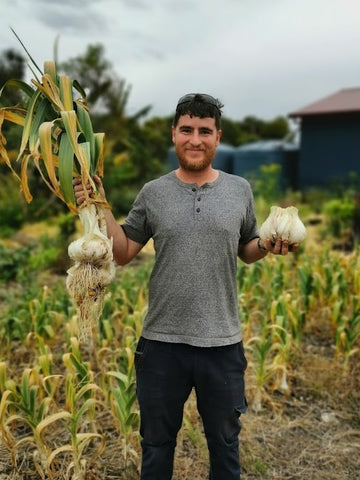Elephant garlic (Allium ampeloprasum), or Russian garlic as it is sometimes known, is a unique and versatile member of the Allium family, known for its mild flavour and enormous bulbs. Despite its name, it is not a true garlic but is actually a close relative of the leek family and a useful perennial to add to your permaculture garden.

Size Comparison of Elephant Garlic vs. Purple Stripe Garlic
Growing Elephant Garlic
Soil Preparation: As garlic has a long growing period and is a heavy feeder, soil preparation is key to getting your garlic off to a good start and developing well formed bulbs. Preparing your soil well with plenty of rich organic matter like well aged compost (ideally homemade), blood and bone, rock minerals, and manure such as well aged pig manure or pelletised chicken manure. If you have heavy clay or compacted soils, some gypsum added well in advance will ensure that your garlic has plenty of room to grow. Garlic in general does not like too much competition so remove any weeds - particularly those with thick tap roots that may impede the growth of healthy bulbs.
Planting: Elephant garlic is grown from cloves, just like traditional garlic. When separating your cloves, choose the largest and healthiest looking cloves for planting. Planting season in the south west of WA is March to May.
Spacing: Give your Elephant garlic plenty of space to grow. Plant the cloves about 20 - 30cm apart as the larger spacing allows these giant bulbs to develop without overcrowding.

Elephant Garlic Growing in Garden Bed
Sunlight: Elephant garlic thrives in full sunlight. Ensure your winter garden bed receives at least six hours of direct sunlight each day. Alternatively, you can plant in a root pouch where you can easily move your garlic to a sunnier spot if required.
Watering: Keep the soil consistently moist, especially during the growing season. Elephant garlic prefers moderate watering, and it's crucial not to let the soil dry out completely. Mulching with a good quality straw mulch can help retain moisture and suppress weeds. Conversely ensure your soil is free draining - particularly if planting in pots as too much moisture can result in the bulbs rotting.
Companion Planting: While garlic does not like too much competition, there are several plants that benefit from being planted near garlic for their ability to deter pests or alternatively, aid the healthy growth of your Elephant garlic crop. Nasturtiums for example can help garlic by providing a living mulch and suppressing weed growth, while garlic planted in a ring around your roses can deter pests like spider mites and can reduce incidents of black spot. Kale, another cool weather crop, is a great way to incorporate a productive food crop into the long garlic growing time as it takes up little space as it grows upward, while the garlic repels many of the bugs that commonly attack kale plants. Other shallow rooted leafy greens like lettuce and spinach can also be planted around garlic as they access their nutrients at a different level to garlic.
Harvesting: Elephant garlic is typically ready for harvest in late spring to early summer, depending on your location and the weather conditions. Harvest when the leaves start to yellow and topple over. Carefully dig up the bulbs, being careful not to damage them.
Curing and Storage: Once you have harvested your Elephant garlic bulbs, gently brush off as much soil from the bulbs as possible. Lay them on a wire rack or hang in a cool dark spot with good air flow to cure them for a minimum of 3 weeks. Once cured, cut off the stems and long roots and store in a cool, dry and airy space. If cured and stored properly, Elephant garlic should keep for up to 8 months in climates with low humidity.

Elephant Garlic Curing on Racks at Galloway Springs Farm
Growing as a Perennial: If left alone, and not harvested, Elephant garlic will survive for multiple years, spreading into a clump with many flowering heads which look fabulous in the garden and can be a great addition to wildlife gardens, perennial beds or polycultures as they encourage lots of beneficial insects to make a home in your garden. You can also harvest the flowering green stalks (or scapes) as they grow to use as a substitute for leeks and the pretty flowers are also edible. Cutting off the scapes also helps your garlic plants focus on bulb growth which can result in bigger bulbs forming over a longer period of time.

Elephant Garlic Scapes
Saving Seed: If you are wanting to save the seed for future planting seasons, pick the largest and healthiest cloves out of the bulb and save these for seed as these will then go on to produce successively larger bulbs with each planting season. How big will you be able to get your Elephant garlic to grow? The record to beat is by South Australian hobby farmer Jon Thompson, who holds the Australian record at 1092 grams!

Farmer Jon Thompson with his Elephant Garlic weighing over 1kg!
Culinary Uses of Elephant Garlic:
Raw: Elephant garlic has a milder flavour compared to other commonly available garlic varieties like the Purple Stripe and Rojo, making it a versatile addition to a variety of dishes, even when used raw. Its subtle taste allows for more flexibility in recipes where a hint of garlic is desired without overpowering other flavours. Try grating your garlic on a microplane to amp up the flavour of a tomato salad or use up your stale bread to make some croutons and rub a raw clove of garlic over the slices to add to the flavour profile.
Roasting: Roasting Elephant garlic brings out its sweet and nutty undertones. Simply cut off the top of the bulb, drizzle with olive oil, and roast until soft. The resulting creamy cloves can be spread on bread or used as a flavourful addition to dips and spreads.
 Roasted Elephant Garlic
Roasted Elephant Garlic
Sautéing and Stir-Frying: Chop Elephant garlic cloves and sauté or stir-fry them to add a mild garlic flavour to pasta, vegetables, or stir-fried dishes. The mildness of elephant garlic allows it to complement rather than dominate the dish.
Pickling: Your Elephant garlic can be preserved by pickling the cloves. Use them as a zesty addition to salads, antipasti platters, or as a tangy garnish for various dishes.
Scapes and Flowers: The scapes have a mild sweet flavour similar to that of leeks and can be used as a substitute where leeks are not available. They also make a great pesto or can be used in asian cooking in place of garlic chives. The edible flowers make attractive garnishes for your culinary creations.

Stir frying Elephant Garlic Scapes
By following these simple steps for growing, and exploring its diverse uses in the kitchen, you'll unlock the full potential of this fascinating allium. Whether you're a gardening enthusiast or foodie (or both like me), Elephant garlic offers a unique and rewarding experience from soil to plate.
Can't get enough garlic? Why not check these other great Garlic blogs:
How to Grow Great Garlic from Cloves
Growing Good Health with Garlic
Seasonal Recipe: Roasted Fennel with Garlic and Herbs






Leave a comment (all fields required)